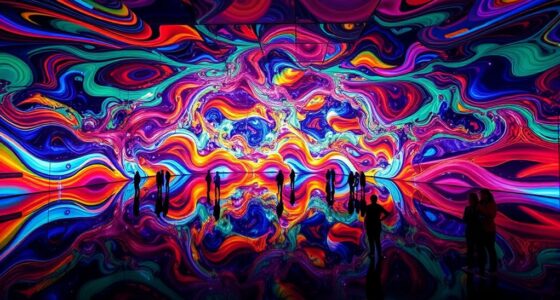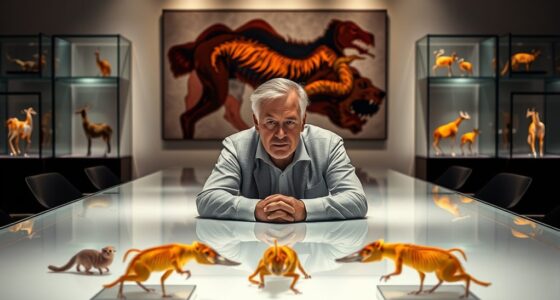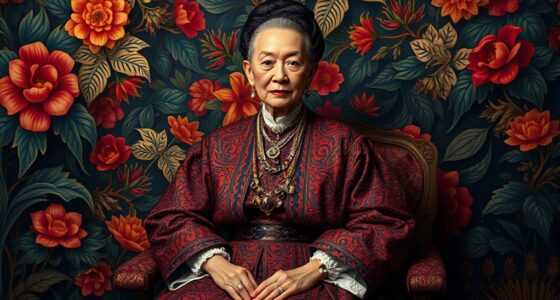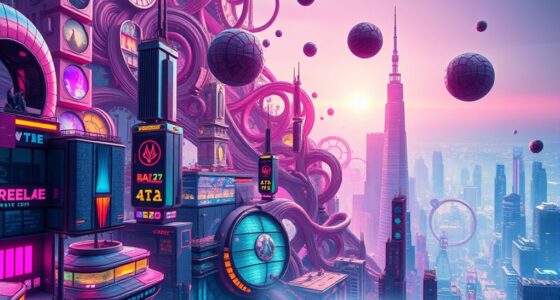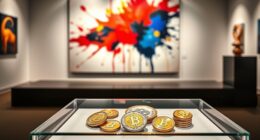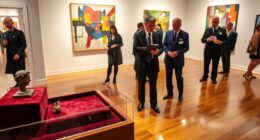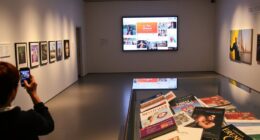Takashi Murakami revolutionized pop art by blending traditional Japanese art with contemporary culture, creating the Superflat movement. You’ll see how he combines vibrant, flat imagery inspired by anime, manga, and ukiyo-e prints to challenge distinctions between high and low art. His work critiques consumerism and media influence while embracing otaku culture. Exploring his innovative techniques and global impact reveals how Murakami’s ideas continue shaping modern art and pop culture—if you want to uncover more, there’s plenty to discover beyond this overview.
Key Takeaways
- Takashi Murakami developed the Superflat aesthetic by blending traditional Japanese art with pop culture influences like manga and anime.
- His exposure to Western art and encounters with artists like Joseph Beuys inspired critical perspectives on consumerism and the art market.
- Superflat emphasizes flat, two-dimensional imagery, bold outlines, and vibrant colors rooted in post-war Japanese visual culture.
- Murakami’s work merges high art with commercial pop culture, challenging traditional boundaries and encouraging East-West cultural exchange.
- His collaborations with brands and celebrities have popularized Superflat, making it a globally influential style in contemporary pop art.
The Origins of Takashi Murakami’s Artistic Vision

Takashi Murakami’s artistic vision has deep roots in traditional Japanese art, which he studied extensively at Tokyo National University of Fine Arts and Music. You would learn Nihonga, a refined Japanese painting style, mastering traditional techniques and forms. However, Murakami grew dissatisfied with the insular nature of traditional art, prompting him to seek new influences. His exposure to Western art, especially after meeting Joseph Beuys in 1984, sparked a critical perspective on the Western art market. Traveling to New York exposed him to global trends, inspiring a blend of traditional Japanese motifs with contemporary themes. His early works, including performance and conceptual art, reflected playful critique and social commentary, laying the foundation for his unique artistic approach rooted in both tradition and modernity. This exposure broadened his understanding of global contemporary art, shaping his innovative style. Additionally, Murakami’s development of the Superflat style combined traditional Japanese art with pop culture elements, creating a distinctive visual language that revolutionized modern art. His recognition of the importance of cultural hybridity helped him forge a new path that bridged multiple artistic worlds. Notably, his unique approach also integrates traditional techniques with contemporary influences, allowing him to innovate while respecting heritage. Recognizing the significance of cultural exchange, Murakami actively incorporates diverse artistic traditions to enrich his work. Embracing a multidisciplinary approach, he blends various cultural and artistic disciplines to foster innovation.
Exploring the Aesthetic Foundations of Superflat
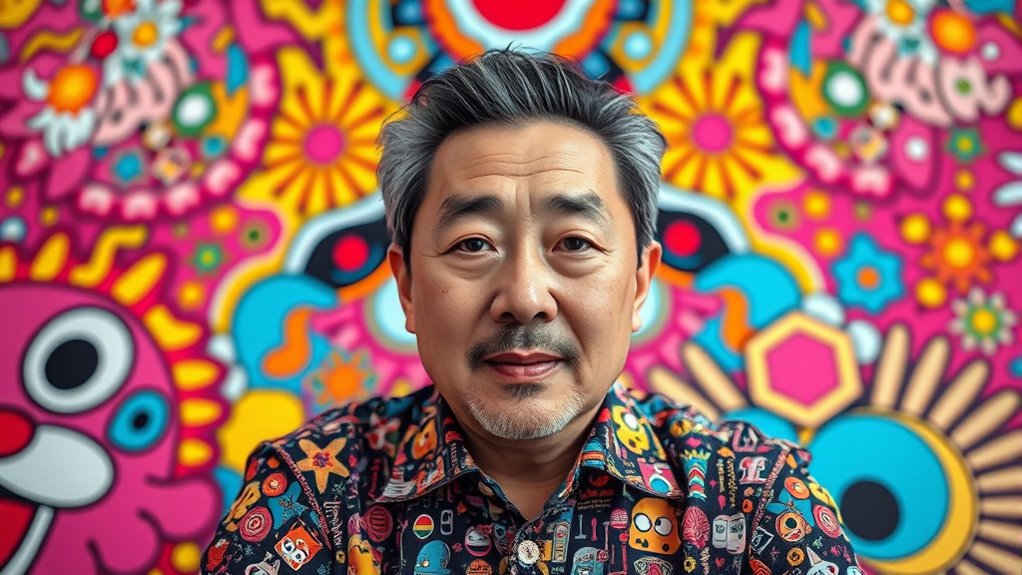
The aesthetic foundations of Superflat are rooted in Japan’s post-war visual culture, where flatness became a powerful tool for critique and expression. You see, Superflat emphasizes the flatness of modern Japanese visuals, critiquing consumer culture’s superficiality. It merges elements of pop culture—anime, manga—with traditional art styles, blurring high and low art boundaries. Strong outlines and vibrant, flat planes of color draw from traditional Japanese aesthetics, creating a bold visual language. By incorporating imagery from mass media and globalized culture, Superflat expands Pop Art’s influence, making art more accessible and playful. It challenges conventional norms, combining 2D and 3D forms across disciplines, and offers a critique of superficial consumerism. This approach transforms art into a hybrid, culturally rich dialogue rooted in post-war Japan’s complex visual landscape. Superflat was officially named and promoted by Takashi Murakami in the early 1990s, solidifying its place in contemporary art discourse. Additionally, the movement’s emphasis on visual flatness reflects broader trends in digital art and media, further influencing contemporary aesthetics. Moreover, the integration of traditional Japanese aesthetics with contemporary pop culture elements exemplifies the innovative blending of cultural influences characteristic of Superflat. The movement also draws on media saturation, highlighting the pervasive presence of images in modern society, which contributes to its critique of consumerism. Furthermore, the use of flatness techniques in various media demonstrates how Superflat’s principles extend beyond traditional painting into digital and commercial art forms. Recognizing the cultural hybridity within Superflat reveals its role in shaping a uniquely Japanese yet globally resonant artistic language.
Traditional Japanese Art Forms and Their Influence

Traditional Japanese art forms have deeply shaped the visual language of Superflat, blending centuries-old techniques with contemporary aesthetics. You can see how ancient pottery, like Jōmon cord-marked designs, influenced surface patterns and symbolism in modern art. The vibrant narratives of Yamato-e painting, depicting landscapes and stories, echo in Superflat’s storytelling approach. Ukiyo-e woodblock prints, with their bold lines and focus on popular culture, directly inspire Superflat’s flat, graphic style and its commentary on urban life. Additionally, Zen calligraphy’s emphasis on spontaneity and imperfect beauty informs Murakami’s playful, bold lines. The cyclical development of Japanese art, from Chinese influence to indigenous styles, reflects a continuous blending of traditional motifs with new ideas, which is evident in Superflat’s fusion of classic and contemporary visuals. Japanese aesthetic values emphasize simplicity and subtlety, which are central to the flat and minimalistic qualities of Superflat. Moreover, the integration of traditional techniques with modern mediums illustrates how historical art forms continue to influence contemporary artists like Murakami.
The Role of Pop Culture and Otaku Subculture

You can see how Otaku culture heavily influences Murakami’s art, blending anime and manga aesthetics into his work. These pop culture elements challenge traditional ideas of fine art by incorporating familiar, mass-produced imagery. By doing so, he highlights the deep connection between contemporary art and the vibrant world of Otaku and pop culture. Furthermore, Murakami’s integration of these elements helps to dissolve the boundaries between high art and commercial aesthetics, fostering a more inclusive understanding of artistic expression and its evolving nature. Additionally, his use of mass-produced imagery emphasizes the impact of consumer culture on modern artistic practices.
Otaku Influence on Art
How has otaku culture transformed contemporary art? You see, otaku culture’s obsession with anime, manga, and video games has deeply influenced art’s visual language and thematic focus. Its bold, colorful, exaggerated style emphasizes youth, fantasy, and nostalgia, blending traditional Japanese motifs with modern pop aesthetics. This cultural shift encourages active fan participation through cosplay, fan art, and collectibles, fostering a participatory art scene. Otaku themes also challenge conventional notions of high art by merging transmedia storytelling across manga, anime, and merchandise. Artists like Murakami incorporate otaku elements into their work, creating a “Superflat” style that bridges pop culture and fine art. This influence pushes boundaries, reshaping how society perceives and engages with contemporary art. Additionally, AI tools analyze trends in otaku culture to inspire new artistic expressions and reach wider audiences.
Pop Culture Aesthetics
Pop culture aesthetics have become central to contemporary art, especially through the influence of otaku subculture. You see this in Superflat art’s vibrant colors and expressive characters borrowed from manga and anime. It blends high art with commercial pop culture, challenging traditional boundaries. This style promotes East-West cultural exchange, creating a unique visual language that appeals globally. By referencing popular characters and motifs, Superflat connects directly with otaku culture, fostering community and experimentation. The use of hyper-saturated colors and playful imagery reflects pop culture’s influence, while also serving as a critique of consumerism and superficiality. Collaborations with luxury brands further integrate pop culture into high art, making the style both accessible and influential worldwide. Ultimately, pop culture aesthetics shape Superflat’s innovative, boundary-pushing artistic legacy.
Key Characteristics and Techniques of Superflat Art
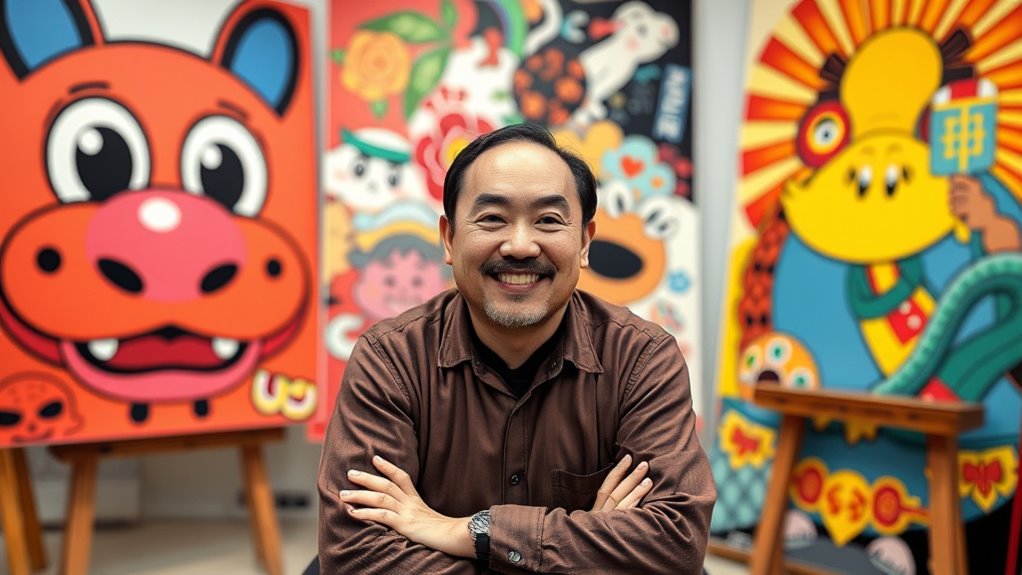
Superflat art is characterized by its bold, graphic style that emphasizes two-dimensionality. You’ll notice strong, clear outlines that define shapes without shading or depth cues, creating a flat, graphic look. You can see how this approach redefines visual perception by focusing on surface and form rather than traditional depth. The use of broad, flat color areas, free of gradation, reinforces this sense of two-dimensionality. This style deliberately rejects traditional depth and volume, focusing instead on visual and conceptual flatness. Expect vibrant palettes inspired by anime and manga, often featuring iconic motifs like smiling flowers or simplified characters that boost commercial appeal. Additionally, the style often incorporates repetitive motifs, which serve to reinforce branding and visual impact. This emphasis on surface over illusion is central to the Superflat movement and its critique of consumer culture. The movement’s focus on mass production techniques highlights Murakami’s blending of commercial art with fine art, emphasizing the movement’s commentary on consumerism and pop culture.
Murakami’s Innovations and Multimedia Integration
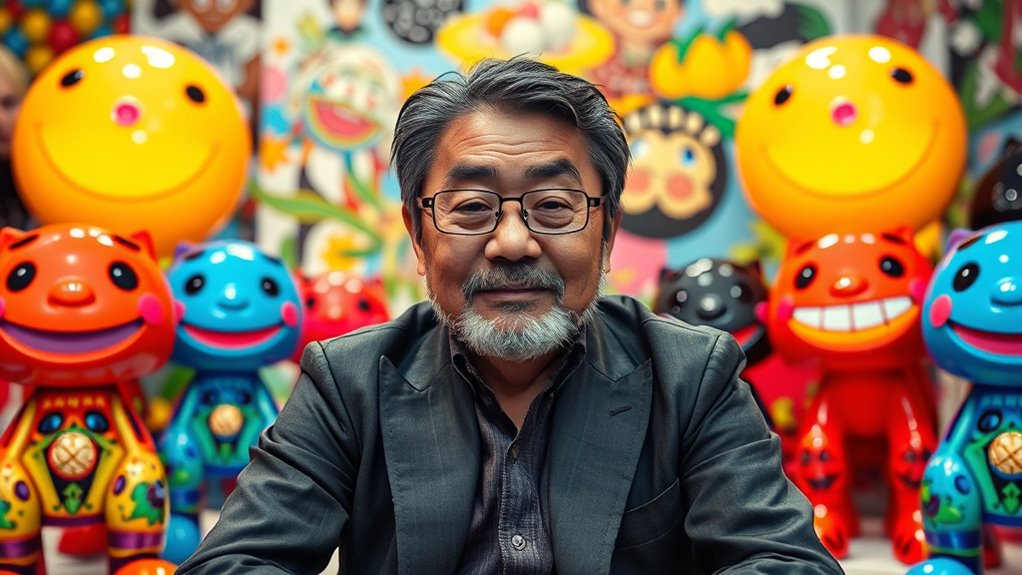
You see how Murakami pushes boundaries by blending different media and modern techniques into his art. He incorporates digital tools, animation, and collaborations with music, fashion, and film to create immersive experiences. This innovative approach transforms traditional art forms into dynamic, multimedia expressions that resonate across cultures. Additionally, his integration of digital tools and multimedia elements exemplifies how contemporary artists expand the boundaries of traditional art. Murakami’s use of multimedia integration demonstrates a forward-thinking approach that bridges various artistic disciplines and audiences. His work often explores cross-disciplinary collaboration, further emphasizing his commitment to breaking conventional artistic boundaries.
Multimedia Techniques
How has Takashi Murakami transformed traditional art through innovative multimedia techniques? By integrating digital tools, he creates highly detailed, vibrant works that push beyond conventional boundaries. His use of digital platforms allows him to craft immersive, intricate designs like “The 500 Arhats,” featuring hundreds of digital characters. Murakami combines traditional Japanese techniques, such as calligraphy and ukiyo-e influences, with digital media, blending historical motifs with contemporary pop culture. He seamlessly embeds anime and manga elements into his digital pieces, challenging cultural norms. His multimedia collaborations span music, fashion, and film, expanding his reach. Murakami’s work bridges fine art and commercial industries, showcasing digital and multimedia works in major exhibitions worldwide. This approach transforms how audiences engage with contemporary art through interactive, immersive digital displays.
- Utilizes digital art software for complex compositions
- Merges traditional techniques with digital media
- Collaborates across pop culture and commercial sectors
Artistic Innovation
Takashi Murakami’s artistic approach pushes the boundaries of conventional art by integrating innovative multimedia techniques that redefine visual expression. You’ll notice how he creates the Superflat style by blending pop culture with traditional Japanese aesthetics, resulting in flattened compositions without perspective. Murakami combines motifs from anime, manga, and otaku culture, challenging Western art paradigms. His work employs recurring characters like Mr. DOB and motifs such as skulls and mushrooms, mixing grotesque and adorable elements to evoke complex reactions. He shifts from 2D paintings to 3D sculptures using advanced 3-D printing, translating sketches into glossy physical forms. Murakami’s experimentation extends to installations, wallpaper, and merchandise, pushing art into new media and proving Superflat’s versatility while delivering sharp social commentary.
Cultural Critique and Social Commentary in Superflat
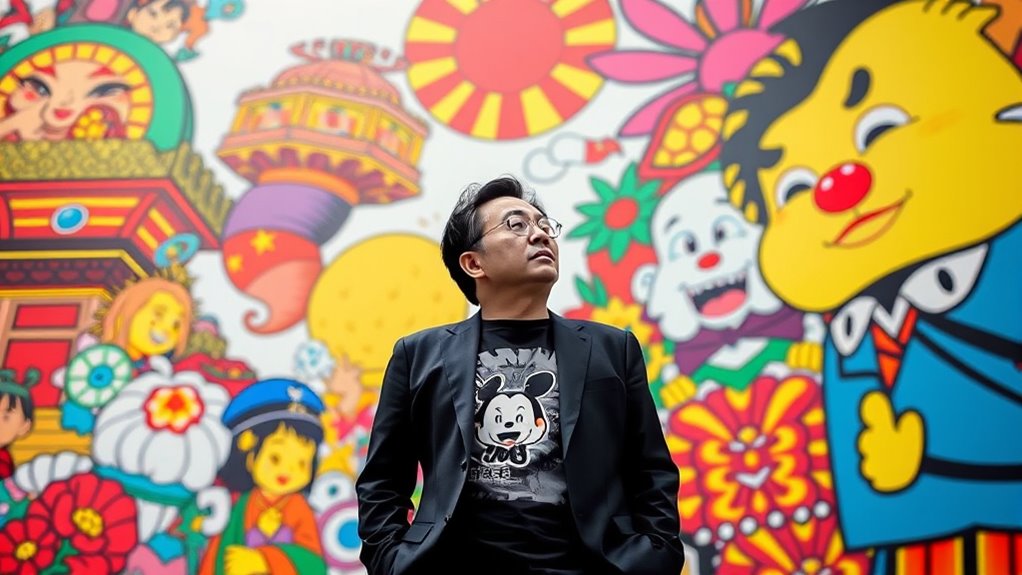
Superflat art serves as a sharp critique of consumer culture and the superficiality pervasive in contemporary society. You see, Murakami’s work exposes how visuals can be empty yet overwhelming, reflecting the shallow nature of mass media and capitalism. It blurs lines between high art and commercial products, critiquing how market forces homogenize cultural identity. You’ll notice this flattening effect extends beyond images to cultural consumption itself, revealing a world obsessed with surface rather than substance. Murakami’s art challenges traditional hierarchies by merging fine art with pop culture like anime and manga, democratizing access and questioning elitism. It also offers a pointed reflection on Japan’s postwar obsession with appearance, revealing contradictions between cultural heritage and globalization, all through playful yet critical visuals.
Superflat critiques superficial consumerism, blending high art with pop culture to challenge cultural homogenization and Japan’s postwar obsession with appearance.
- Critiques superficial consumerism and media influence
- Blurs distinctions between high art and commercial culture
- Reflects on Japan’s cultural identity amidst globalization
The Global Reach and Impact on Contemporary Art

The global influence of Superflat art has become evident through its widespread exhibitions, recognition, and integration into international markets. You can see its reach in major cities like Paris, where Murakami’s work is showcased alongside renowned artists, gaining international acclaim comparable to Warhol’s. The style fuses traditional Japanese motifs with Western pop culture, creating a cross-cultural aesthetic appreciated worldwide. Murakami’s influence extends beyond Japan, inspiring artists globally and shaping contemporary art discourse. His vibrant colors, anime-inspired characters, and storytelling approach resonate with diverse audiences, making Superflat a significant force in today’s art scene. This global presence highlights how Murakami’s work bridges cultures, impacts markets, and elevates contemporary art’s international dialogue.
Collaborations and the Future of Superflat Pop Art
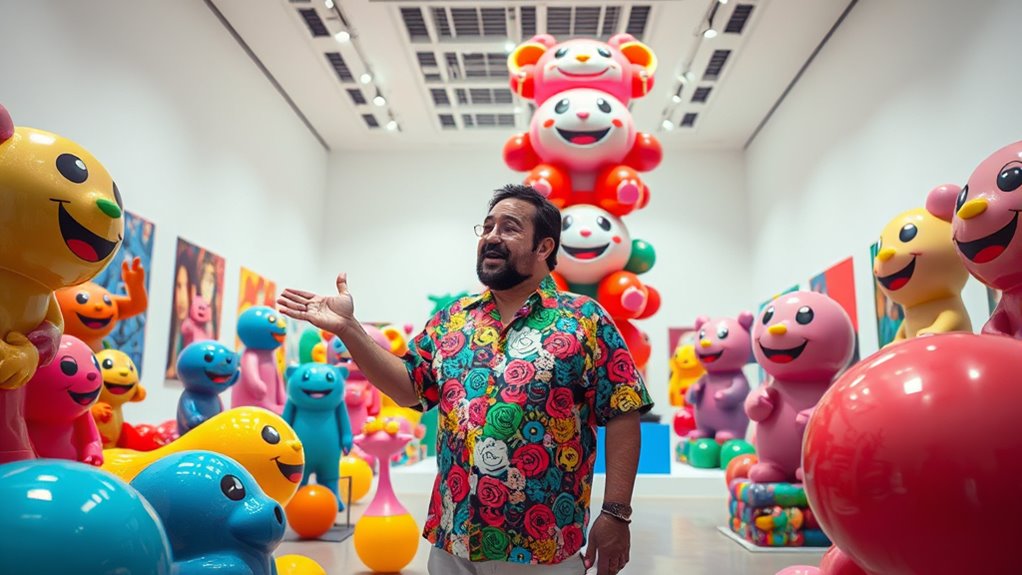
Collaborations have become a vital force shaping the future of Superflat pop art, allowing it to extend beyond traditional gallery spaces and into mainstream culture. By partnering with global brands, musicians, and fashion labels, Murakami’s style reaches wider audiences and evolves with contemporary trends. These collaborations include Louis Vuitton, Pharrell Williams, Kanye West, Supreme, and Billie Eilish, blending high fashion, music, and streetwear. They also influence product design, making Superflat motifs common on apparel, toys, and consumer goods. This cross-industry presence challenges traditional art boundaries and emphasizes mass production and accessibility. As digital platforms grow, expect more NFT collaborations and virtual projects, ensuring Superflat stays relevant. Murakami’s ongoing partnerships will continue to fuse art with popular culture, shaping its future trajectory.
- Partnering with brands like Louis Vuitton and Supreme expands Superflat’s reach.
- Incorporating digital art and NFTs signals adaptation to new markets.
- Collaborations with musicians and entertainment icons foster cultural relevance.
Frequently Asked Questions
How Did Takashi Murakami Develop His Unique Artistic Style?
You notice that Murakami developed his unique style by blending traditional Japanese art, like ukiyo-e, with contemporary pop culture. He emphasizes flatness and vivid colors, inspired by anime and manga, creating a playful yet critical view of modern society. His work combines high and low art, often using mass production techniques, making his art accessible and commercially successful while commenting on consumerism and cultural influences.
What Are the Main Influences Behind Superflat’s Visual Aesthetic?
You see, the main influences behind Superflat’s visual aesthetic include vibrant colors, bold patterns, and a blend of traditional Japanese motifs with modern pop culture. You notice how anime, manga, and video games shape its playful yet surreal look. You also recognize the impact of Western pop art, like Andy Warhol, which encourages mixing high and low culture, creating a distinctive style that’s both lively and thought-provoking.
How Does Superflat Challenge Traditional Distinctions Between High and Low Culture?
You see, superflat challenges traditional distinctions between high and low culture by blending elements from both seamlessly. It uses popular manga, anime, and commercial imagery alongside fine art, blurring the lines that once separated them. This movement invites you to reconsider what’s considered “elite” or “popular,” emphasizing that cultural value isn’t limited by hierarchy. Instead, it creates a new, unified visual language that reflects contemporary society’s interconnectedness.
In What Ways Has Superflat Influenced Global Fashion and Consumer Products?
Imagine walking into a store and seeing sneakers covered in bold, cartoonish colors—like stepping into a living pop art mural. Superflat has transformed fashion and consumer products by blending vibrant, flat graphics into everyday items. You’ll find its influence on limited-edition collaborations, streetwear, and luxury accessories. This movement makes art accessible, turning your favorite products into wearable and collectible pieces that blur the line between high and low culture.
What Future Directions Might Superflat Pop Art Take in Contemporary Culture?
You might see superflat pop art evolve by blending more global cultural influences and cutting-edge technologies like AI and virtual reality. It could focus on pressing issues such as environmental sustainability while maintaining its vibrant, accessible style. As it expands through international exhibitions and digital platforms, expect more interdisciplinary collaborations and community-focused projects. This movement will likely continue challenging traditional art boundaries, engaging audiences, and reflecting contemporary social and cultural themes.
Conclusion
You might be surprised to learn that Takashi Murakami’s Superflat art has influenced over 300 global brands, blending traditional Japanese aesthetics with pop culture. This fusion creates a vibrant, accessible style that’s reshaped contemporary art. As you explore Murakami’s work, remember how his innovative approach continues to break boundaries, inspiring a new generation of artists worldwide. Superflat isn’t just art; it’s a cultural movement transforming how we see and engage with pop culture today.



